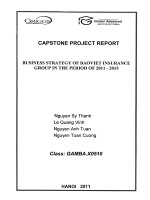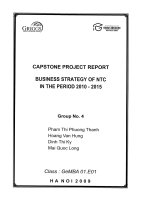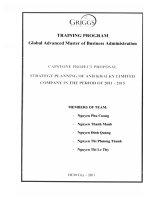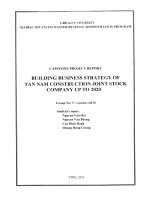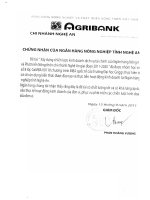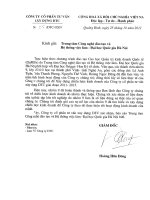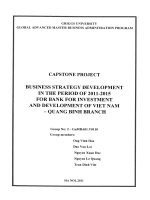Taxi business strategy of Mai Linh group in period of 2011 - 2015
Bạn đang xem bản rút gọn của tài liệu. Xem và tải ngay bản đầy đủ của tài liệu tại đây (1.63 MB, 95 trang )
CAPSTONE PROJECT REPORT
TAXI BUSINESS STRATEGY OF MAI LINH
GROUP IN PERIOD OF 2011 - 2015
Student’s name of group 5
NGUYEN THI THUY DUNG
PHAM DANG HUNG
NGUYEN NGOC QUANG
NGUYEN THUY QUYNH
PHAM MINH SUONG
HO NGOC TRAN
CLASS: GaMBA01.C0609
Ho Chi Minh City, 2011
20
11
GLOBAL ADVANCED MBA PROGRAM
(Class): GaMBA
01
.C0609
Group No
.5
ASSURANCE
o0o
Group 5 pledge to Programs, the subject of this study is that our
group which based on theory and practical business situation at JSC
Mai Linh Group.
The data used in this thread are true, the proposed strategies and
solutions given are based on the research process and discussions of
our group.
Group 5
ACKNOWLEDGEMENT
o0o
First, Group 5 would like to thank the Center for Training and Technology
Systems Jobs National University of Hanoi, has created conditions for us to
participate in the training course under training programs of Griggs University -
United States.
Training program at the University of Griggs - United States has added to our
knowledge of many business administration scientifically and our experience to
improve skills, in management, the organization in general and in particular myself.
We also thank the teachers who participate in teaching, communicate knowledge
and the members of the program have supported us in the course.
In addition, my group thanks Corporation Mai Linh Group which has created
conditions for the group to use the materials on the business in recent years as data
to illustrate article, as well as assisting me in reaching the company at a deeper
angle, more realistic.
In this topic, our team will use all knowledge are learned from the Program on
the actual situation of the Corporation Mai Linh Group to build a business strategy
in Taxi in 2011 - 2015 a effectively.
There are no words that can help our team express this profound gratitude. Our
team wish everyone health, good luck to all and happy to reap more successful in
life.
LIST OF ABBREVIATIONS
o0o
EFE : External Factor Evaluation
IFE : Internal Factor Evaluation
MLG : Mai Linh Group
SPACE : Strength Position and Action Evaluation
SWOT : Strengths-Weeknesses-Opportunities-Threats
QSPM : Quantitative Strategic Planning Matritx
LIST OF TABLES
o0o
Table 1.1: Strategy process and implementation 7
Table 1.2: Example of EFE Matrix 8
Table 1.3: Example of Competitive Image Matrix 8
Table 1.4: Example of IFE Matrix 9
Table 1.5: Example of SWOT Matrix 9
Table 1.6: Example of QSPM Matrix 10
Table 2.1: Number of workers to date 30/04/2011 16
Table 2.2: Mai Linh Group JSC operation results 19
Table 2.3: Mai Linh Group JSC balance sheet 21
Table 2.4: Revenue through the years 24
Table 2.5: Structure of sales by region in 2010 27
Table 2.6: Gross profit by industry through the years 29
Table 2.7: Analysis of financial indicators 31
Table 2.8: Synthesis and forecast of the socio economic criteria 2008 – 2015 36
Table 2.9: Number of transport passengers 39
Table 2.10: The number of taxis in areas to date 05/2011 41
Table 2.11: EFE Matrix of Mai Linh 46
Table 2.12: IFE Matrix of Mai Linh 56
Table 2.13: SWOT Matrix of Mai Linh 58
Table 2.14: Competitive Image Matrix of Mai Linh 59
Table 2.15: SPACE Matrix of Mai Linh 60
Table 2.16: BCG Matrix of Mai Linh 62
Table 2.17: QSPM Matrix of Mai Linh 65
LIST OF FIGURES
o0o
Figure 1.1: Process implementing Strategy 3
Figure 1.2: Five competitive forces model 6
Figure 1.3: Value Chain of Company 7
Figure 2.1: Mai Linh Group Organizational chart 15
Figure 2.2: Workforce’s structure of MLG 17
Figure 2.3: Taxi vehicles’ growth 17
Figure 2.4: Types of taxi up to May 2011 18
Figure 2.5: Revenue over the years 25
Figure 2.6: Revenue of each branch 26
Figure 2.7: Taxi service revenue structure in 2010 by region 28
Figure 2.8: Gross profit/ net revenue chart over the years 30
Figure 2.9: Real GDP growth rate over the years 2011 – 2015 37
Figure 2.10: Petrol price fluctuations over the years 38
Figure 2.11: Passengers serviced fluctuations graph 39
Figure 2.12: Structure of passenger transportation by 2009 40
Figure 2.13: Value chain of MLG 47
Figure 2.14: Graph of SPACE matrix vecto 61
Figure 2.15: Graph of BCG matrix 62
Figure 2.16: Major strategy matrix 64
APPENDIX
o0o
ACKNOWLEDGEMENT
LIST OF ABBREVIATIONS
LIST OF FIGURES
LIST OF TABLES
INTRODUCTION
CHAPTER 1: BASIC THEORY AND PRACTICE OF TAXI BUSINESS
STRATEGY
1.1 Concepts, planning process and strategy implementation 1
1.1.1 Concepts 1
1.1.2 Role, importance of strategy and strategic management 3
1.2 Content of strategic management 4
1.2.1 Defined vision and mission of the enterprise 4
1.2.2 External environment analysis 5
1.2.3 Inside environment analysis 6
1.3 Planning process and strategy implementation 7
1.3.1 External factors assessment Matrix 8
1.3.2 Competitive image Matrix 8
1.3.3 Internal factors assessment matrix 9
1.3.4 SWOT Matrix 9
1.3.5 QSPM Matrix 10
1.4 Concept and characteristics of services and taxi service 11
1.4.1 Concept of service and taxi service 11
1.4.2 Taxi service characteristics 11
1.4.3 Assessing the quality of taxi service 12
CONCLUSION OF CHAPTER 1 13
CHAPTER 2: ANALYZING THE MAI LINH GROUP IN THE PERIOD
2008-2010
2.1. About Mai Linh Group (MLG) 14
2.1.1. Incorporation and Development History: 14
2.1.2. Organizational chart 15
2.1.3. Business results 18
2.1.4 Assessing the main causes affecting the results 35
2.2 Analysis of the external environment - EFE Matrix 36
2.3 Analysis of internal factors - IFE Matrix 47
2.3.1 The company's value chain 47
2.3.2 Define typical value offered to customers 52
2.3.3 Identify strengths and weaknesses 52
2.4 SWOT Matrix 58
2.5 Competitive image Matrix 59
2.6 SPACE Matrix 60
2.7 BCG Matrix 61
2.8 Major strategy matrix 63
2.9 Quantitative Strategic Planning Matritx – QSPM 65
CHAPTER 2 CONCLUSION 67
CHAPTER 3: ORIENTED BUSINESS STRATEGY AND SOLUTIONS
FOR MAI LINH GROUP JSC TAXI BUSINESS DEVELOPMENT IN
STAGE 2011-2015
3.1 Market demand forecast 68
3.2 Vision, mission & objectives of the company 68
3.2.1 Vision 68
3.2.2 Mission 68
3.2.3 Objectives 68
3.3 Strategic Business Plan for 2011-2015 69
3.4 Solutions 78
3.4.1. Marketing solution & market: 78
3.4.2 Financial solution 79
3.4.3 Human resources sulotion 80
3.4.4 Technology sulotion 80
3.5 Conclusion and Recommendation 81
3.5.1 Conclusion 81
3.5.2 Recommendation 82
REFERENCE
INTRODUCTION
o0o
Today, the globalization process has combined the world economy into a
larger overall economy. Vietnam is no exception, when a country joined the WTO
and has a dynamic economy, growing faster than the region. In this context, the
need for communication and travel has become a major problem to be solved.
Currently, there are many options for people to use the transportation such as
buses, motorcycles, passenger cars, taxis… Taxi which plays an increasingly
important role is influential. Increasing living standards have much choice for them.
Taxi is no longer a luxurious choice for many people
Corporation Mai Linh Group is one of the pioneering companies in developing
business is passenger service. After 18 years, Mai Linh company has now gain the
upper hand in this area with nearly 10,000 vehicles (up 29.8% of taxi facilities
nationwide) business in 53/64 provinces and cities nationwide.
Besides, taxi service is a perfect competition, many companies engage in
market services business passengers, so as to make the market more vibrant
inherently more exciting.
Facing the current context, Mai Linh Group, like other corporations,
companies in the market economy, to survive and more sustainable development
strategy, the taxi business in the long term is practical needs and urgency. To
contribute to the success of the Mai Linh and complete the graduation subjects, we
selected groups of subjects "Business Strategy Corporation's Taxi Mai Linh Group
stage 2011 - 2015"
Research methods of this topic based facilities management business theory,
the statistic of the company performance through the years and the basis of data
through market channels to distribute information analysis, synthesis and proposed
strategies and solutions implemented.
Subject is structured into three parts:
• Chapter 1: Basic theory and practice of taxi business strategy
• Chapter 2: Analyzing Mai Linh Group situation stage 2008-2010.
• Chapter 3: Oriented business strategy and solutions for Mai Linh Group jsc
taxi business development in stage 2011-2015.
Graduation Thesis
1
CHAPTER 1
BASIC THEORY AND PRACTICE OF TAXI BUSINESS STRATEGY
1.1 Concepts, planning process and strategy implementation
1.1.1 Concepts
Concept of strategy
− "Strategy is the determination of objectives, basic long-term goals of the
enterprise and the application of a sequence of actions as well as the distribution of
resources necessary to implement this objective” - Chandler (1962) [7, p.31]
− "Strategy is the pattern or plan to integrate the major objectives, policies, and
action sequences into a cohesive whole rigorously" - Quinn (1980) [7, p.31]
− “The strategy is different.− It means that the choice is calculated, of a series
of different activities to create unique value”- Michael E. Porter(1996) [7, p.31]
Thus, although there are many approaches and different definitions, for a
business strategy includes the following contents:
• Identify the basic and long-term objectives of the business
• Give the general program of action
• Select the action plans, deploy and distribute the resources to
accomplish that goal
Concept of strategic management
Strategic Management can be defined as an art and science, establishing,
implementing and evaluating decisions related functionality, which allows an
organization to achieve those goals
Graduation Thesis
2
Strategic management process consists of three phases:
• Strategic planning phase
• Strategy implementation phase
• Strategy assessment phase
Fred R. David has given the comprehensive strategic management model [6,
p.28]. Including the strategic planning phase includes the following steps: defining
the vision, mission, strategic goals, then analyzing the factor regarding the external
environment to identify opportunities and risks, while the analysis applied to the
internal environment to realize strengths and weaknesses of the enterprise, thereby
determining business goals and establishing long-term goals and strategies selected
for implementation. Strategy implementation phase will include the distribution of
resources to make the annual goals and policies. The last phase is the measurement
and evaluation of the implementation strategy.
Graduation Thesis
3
ơ
Distri-
bution of
resources
Re-
determine
business goals
Analyze the
internal
environment to
realize strengths
/ weaknesses
ơ
Strategy
selected
for
implemen-
tation
ơ
Policy
given
Strategy planning Strategy implementation Assessment
Vision,
mission,
strategic
goals
Analyzing the
factor regarding
the external
environment to
identify
opportunities and
risks
ơ
Measure
and
evaluate
the imple-
menta-
tion
of strategy
ơ
E
stablish
long-
term
goals
ơ
Set
annual
goals
Figure 1.1: Process implementing Strategy
Source: Fred R.David, Concepts of strategic management, Statistics Publishing House, 2006
1.1.2 Role, importance of strategy and strategic management
Somewhat, strategies make organizations more sensitive to economic
forecasting and market fluctuations. As a result, right decisions are made and
business operations are controlled to increase competitive advantage. Since then,
progressively ensure their strong position in the market.
• Strategy can be considered the "code of conduct" for businesses and the
last goal for all members to achieve
• Strategy represents the enterprise value.
Graduation Thesis
4
• Strategy for leaders to create business plans and vision for the future.
• Strategy is the creation in enterprise management.
• Strategy represents the company's position.
In his book about "competitive strategy”, Michael Porter has determined that"
strategic competition in the relationship between the company and its market"
Most importantly, companies must build long-term strategies being essential for
business stability and development in the future. However, due to continuous
changes of business environment and changing resources in line with business
strategy in each period, the business strategy must be flexible and tailored to suit the
current situation.
1.2
Content of strategic management
The strategy has been built from the tasks of the business, a basis for
determining the objectives of clients as well as other relevant partners’
Based on these tasks, managers should set objectives. These objectives clearly
outlined the tasks for the company and used to develop action plans and evaluation
process. These objectives are guided by practical knowledge in all markets outside
the business environment and internal capabilities. Typically, strategic planning
begins by carefully studying and analyzing the situation, and takes the priority
actions that businesses need to settle for long-term success.
1.2.1 Defined vision and mission of the enterprise
Strategic vision is a picture, standard, unique image and ideals in the future, as
the enterprises should reach or farming practice.
The task is to understand the reason exists, the meaning of existence and
operation of businesses. Mission more clearly reflect the beliefs and vision to guide
the user has been identified and is usually expressed as a statement about the
mission of the enterprise. Business going?
Graduation Thesis
5
1.2.2 External environment analysis
The purpose of analyzing the external environment is to develop a portfolio of
limiting opportunity that the environment can bring benefits to the company and the
threats that the company should avoid to reduce the risk of harm from the external
environment. There are different external environmental factors (macro
environment and micro environment), the analysis of external environment just
limited to the factors that affect business.
Macro environment: economic environment, political environment and
legislation, sociocultural environment, demographic and geographical environment,
technologiecal, global environmental.
Micro environment: the competitive environment is also known as the industry
environment, the environment is directly associated with the company, most active
and competitive activities of the company are in this environment.
Michael E. Porter, professor of Harvard business strategy has given five
competitive forces model: [6, p.32]
Graduation Thesis
6
Figure 1.2: Five competitive forces model
Source: Fred R.David, Concepts of strategic management , Statistics Publishing House, 2006
1.2.3 Inside environment analysis
In every company there are always strengths and weaknesses in different
business units. Strengths and weaknesses of the internal environment and
opportunities associated with external threats and with the mission statement as the
basis for setting goals and strategies of the company.
The elements of the inside environment such as finance, management,
marketing, human resources, manufacturing and management operations [6, p.35]
ơ
NEW POTENTIAL
COMPETITORS
ơ
SUPPLIER
ơ
CLIENTS
ơ
COMPETITORS IN
INDUSTRY
ơ
ALTERNATIVE
PRODUCTS
Graduation Thesis
7
Figure 1.3: Value Chain of Company.
Source: Fred R.David, Concepts of strategic management , Statistics Publishing House, 2006
1.3 Planning process and strategy implementation
Table 1.1: Strategy process and implementation
Source: Fred R.David, Concepts of strategic management, Statistics Publishing House, 2006
Graduation Thesis
8
1.3.1 External factors assessment matrix
EFE Matrix allows strategists to summarize and evaluate economic, social,
cultural, demographic, geographic, political, government, law, technology and
competition- related information
Table 1.2: Example of external factors assessment matrix
Source: Fred R.David, Concepts of strategic management, Statistics Publishing House, 2006
1.3.2 Competitive image Matrix
Competitive image Matrix identifies the main competititors and their specific
advantages and disadvantages
Table 1.3: Example of competitive image matrix
Source: Fred R.David, Concepts of strategic management, Statistics Publishing House, 2006
The construction of matrix evaluating internal elements will help us
summarize and evaluate the strengths and weaknesses of the important parts of
business function, it affects business production and activities.
Graduation Thesis
9
1.3.3 Internal factors assessment matrix
Table 1.4: Example of internal factors assessment Matrix
Internal environment factors Importance Classification Important points
1/……………………
2/…………………….
Total point
Source: Fred R.David, Concepts of strategic management, Statistics Publishing House, 2006
1.3.4 SWOT matrix
SWOT matrix allows us to assess the strengths and weaknesses of the
company and to estimate the opportunities and risks of external environment. Since
then a combination of factors between the environmental situation and the
Company’s ability into business strategies
SWOT matrix we have is as follows:
Table 1.5: Example of SWOT Matrix
Source: Fred R.David, Concepts of strategic management, Statistics Publishing House, 2006
Graduation Thesis
10
1.3.5 QSPM Matrix
QSPM matrix is aimed to evaluate and rank the strategic plans, from which we
select based on the best strategy for business. This matrix using all information,
data from the matrix mentioned above such as: IFE, EFE, competitive image
matrix, SWOT Matrix,
Table 1.6: Example of QSPM Matrix
Important factors
Optional strategies
Classification
Strategy 1 Strategy 2 Strategy 3
Attraction
points
Total
points
Attraction
points
Total
points
Attraction
points
Total
points
Internal factors
Administration
Finance
Accounting
Marketing Production
Research and
development
Information systems
External factors
Economic
Political
Legal
Social
Cultural
Population
Technology
Total points
Source: Fred R.David, Concepts of strategic management , Statistics Publishing House, 2006
Graduation Thesis
11
1.4 Concept and characteristics of services and taxi service
1.4.1 Concept of service and taxi service
Concept of service
Service is an activity or interest provided for exchange, mostly invisible and
does not lead to the transfer of ownership. Providing services can be attached or not
attached to material products.
Service has the following characteristics:
• Simultaneity: production and consumption occur simultaneously
• Inseparability: production and service consumption can not be separated
• Where there is lack of this side, there is no other side
• Heterogeneous nature: there is no uniform quality
• Invisible: not significant and invisible before consumption.
• Unable storage: No warehouses established as with other goods
Concept of taxi service
Transportation is the process of change (move) the location of passengers in
space and time in order to satisfy the specific needs of certain people.
Taxi is the form of car use (no more than eight seats, including driver's seat) to
change (move) the location of passengers in space and time to satisfy specific needs
for certain human.
Taxi transport service business: a business form of passenger transport by car
and travel schedule is not fixed at the request of passengers, freight charges
calculated according to the taximeter (for passengers).
1.4.2 Taxi service characteristics
• Taxi use demande changes over time, operating time of vehicles 20 - 22
hours per day, driving distance of the big day 200 - 350 km / day.
• Comfortable and convenient use regarding time
Graduation Thesis
12
• Taxi transportation rates are often calculated by the number of times for
'opening car door', distance for passenger using the car and car’s waiting
time at the request of passengers.
• Means of transport for Taxi transport service according to Decree No. 91_CP
by the government are 4 seat- and 7- seat cars, with room for luggage, a
charging automated device called Taximeter, incorporating a light box 'Taxi'
• Taxi use demande depends on many factors: purpose of trip, per capital
income, taxi service rates, etc…
1.4.3 Assessing the quality of taxi service
Service quality is the interference between service quality expectations of
consumers and provided quality service based on four key elements: reliability,
comfort, empathy and accountability.
Quality of taxi services affected by the following factors:
• Qualifications, competence, skills and attitude of drivers.
• Service facilities (vehicles, distance measuring equipment (Taximeter) for
charging, equipment for communications between operations centers &
facilities ).
•
Environment to carry out and delivery services (economic, social, cultural,
legal, etc )
Graduation Thesis
13
CONCLUSION OF CHAPTER 1
In summary, in this group we have compiled, summarizing the theory of systems
concept, the theory of economics to serve the strategy, planning processes and tools
to serve strategy for a company's business in general and Corporation Mai Linh
Group in particular.
In the two chapters after, our team combined the theoretical basis of this chapter
on the actual situation of the Corporation Mai Linh Group, the external environment
for strategic planning and business Taxi Company Stock Mai Linh Group stage
2011 - 2015 an effective and feasible.
Graduation Thesis
14
CHAPTER 2
ANALYZING MAI LINH GROUP SITUATION STAGE 2008-2010.
2.1. About Mai Linh Group (MLG):
2.1.1. Incorporation and Development History:
Company name : Mai Linh Group
Headquarters : 64 -68 Hai Ba Trung, Ben Nghe Ward, Ho Chi Minh City
Telephone No. : (84-8) 8.298.888 Fax: (84-8) 8.225.999
Website : www.mailinh.vn
The Company was incorporated on
12/07/1993, with an initial capital of
300 million VND, the initial number of
employees was 25 persons, business
sectors in the first phase are: Car rental
(with two cars first), airline ticket
agency, etc with main activities
within Ho Chi Minh City.
After 18 year- operation, actually
Mai Linh Group JSC is the leading
Company in the country for transport
service locally. The company's
participation in the taxi service market
has contributed somewhat to solve the
transportation needs of people.
Mai Linh has currently developed
its equity up to 875 billion VND and
assets of 2893 billion VND, with over
10,000 vehicles and has attracted over


